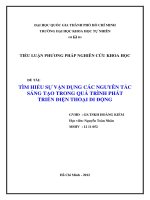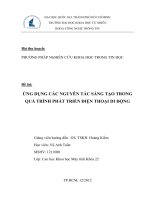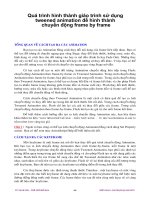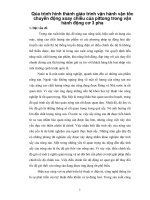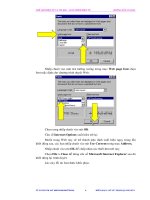Quá trình hình thành giáo trình chuyên ngành điện tử viễn thông - mạng điện thoại tiếng anh chuyên ngành p7 ppsx
Bạn đang xem bản rút gọn của tài liệu. Xem và tải ngay bản đầy đủ của tài liệu tại đây (436.37 KB, 8 trang )
Unit 4. Optical Fibres
47
• Khi mô tả các mối tương quan, các tính từ được dùng ở cấp so sánh.
• “great” và “large”: thường dùng để chỉ kích cỡ hay số lượng.
• “high” ngược nghĩa với “low”; “great, large” ngược nghĩa với “small” hoặc đôi khi: “few”
(mô tả số lượng)
• Khi nói về mức độ (degree) hay tần số (frequency) thì thường dùng “higher” hay “lower”
để nói rằng “càng lớn” hay “càng nhỏ”.
Practice 2.1. Make sentences for the following relationships.
a. Frequency and number of samples/sec. (tỷ lệ thuận)
………………………………………………………………………………………………
b. Number of channels and cost of transmission. (tỷ lệ nghịch)
………………………………………………………………………………………………
c. Degree of network digitalization and number of exchanges. (tỷ l
ệ nghịch)
………………………………………………………………………………………………
d. Degree of automation and number of manual operators. (tỷ lệ nghịch)
………………………………………………………………………………………………
2.2. Explain more precise relationships
Muốn mô tả chính xác các mối tương quan phải đề cập tới tỷ lệ (ratio).
Ví dụ: The sampling rate is double the frequency
The frequency is a half of/ is half the sampling rate.
Note:
• Tỷ lệ 3:1 -> treble/ three times
• Tỷ lệ 4:1 -> four times, 5:1 -> five times,
• Tỷ lệ 1:2 -> a half of / half
• Tỷ lệ 1:3 -> one third of
• Tỷ lệ 1:4 -> one fourth of = a quarter of,
Practice 2.2. Now make sentences for more precise relationships. (In each case you can make
more than one sentence.)
a. Return on investment £2,000: original investment £500
………………………………………………………………………………………………
b. New system 48 channels: old system 24 channels
………………………………………………………………………………………………
c. Cable costs 1985 £500 per kilometre: cable costs 1980 £125 per kilometre
………………………………………………………………………………………………
d. New distance between repeaters 2 km: old distance between repeaters 6 km
………………………………………………………………………………………………
e. The pulse rate 8,000 per second: the capacity 16,000 per second
Unit 4. Optical Fibres
48
………………………………………………………………………………………………
3. READING 2
Read the following text carefully.
PULSE CODE MODULATION (PCM)
The process of choosing measuring points on the analogue speech curve is called
sampling. The measurement values are called samples. When sampling, we take the first step
towards a digital representation of the speech signal as the chosen sampling instants give us the
time coordinates of the measuring points.
The amplitudes of the samples can assume each value in the amplitude range of the speech
signal. When measuring the sample amplitudes, we have to round off for practical reasons. In the
rounding-off process, or the quantizing process, all sample amplitudes between two marks on the
scale will be given the same quantized value. The number of quantized samples is discrete as we
have only a discrete number of marks on our scale.
Each quantized sample is then represented by the number of the scale mark, i.e. we know
now the coordinates on the amplitude axis of the samples. The processes of sampling and
quantizing yield a digital representation of the original speech signal, but not in a form best suited
to transmission over a line of radio path. This process is known as encoding. Most often the
sample values are encoded to binary form, so that each sample value is represented by a group of
binary elements. Typically, a quantized can assume one of 256 values. In binary form, the sample
will be represented by a group of 8 elements. This group is called a PCM word. For transmission
purposes, the binary values 0 and 1 can be taken as corresponding to the absence and presence of
an electrical pulse.
Figure 1. Pulse code modulation block
On the transmission line, the pulses in the PCM words will become gradually more
distorted. However, as long as it is possible to distinguish between the absence and the presence
of a pulse, no information loss has occurred. If the pulse train is regenerated, i.e. badly distorted
Sam
p
lin
g
Reconstruction
Decodin
g
Quantizing
Encodin
g
Regeneration
Regeneration Regenera
t
ion
Unit 4. Optical Fibres
49
pulses are replaced by fresh pulses at suitable intervals, the information pulses can be transmitted
long distances with practically no distortion at all. This is one of the advantages of digital
transmission over analogue transmission: the information is contained in the existence or not of a
pulse rather than in the form of the pulse.
On the receiving side, the PCM words are decoded, i.e. they are translated back to
quantized samples. The analogue speech signal is then reconstructed by interpolation between the
quantized samples. There is a small difference between the analogue speech signal on the
receiving side due to the rounding off of the speech samples. This difference is known as
quantizing distortion.
3.1. Main phrases
- rounding off = quantizing process: quá trình lượng tử hóa
- the same quantized value: cùng một giá trị lượng tử
3.2. Find the information to complete the sentences.
Example: The small difference between the analogue speech signal on the receiving side due
to the rounding off of the speech samples is known as: quantizing distortion.
1. The measurement values are called:
2. The process of choosing measuring points on the analogue speech curve:
3. Typically, a quantized can assume:
4. The PCM words are decoded, that means they are:
5. The processes of sampling and quantizing brings:
6. In binary form, the sample will be represented by:
7. In the quantizing process, all sample amplitudes between two marks on the scale:
8. Each quantized sample is:
9. On the receiving side, the PCM words are:
10. One of the advantages of digital transmission is:
4. WRITING
4.1. Use the Figure 2 to order the sentences below to form a text describing a simple FDM
system.
Unit 4. Optical Fibres
50
Figure 2. An FDM system
A. The second and the third channels cannot be transmitted directly over the line.
B. At the receiving end, filters separate the three channels and finally demodulators
restore channels 2 and 3 to their original frequency position.
C. To illustrate the principle of a frequency division multiplex (FDM) system, consider
the simple case of transmission of 3 telephone channels, of bandwidth 300- 3400 Hz,
over a common line.
D. Now, the three channels can be passed over the common line, boosted at intervals as
necessary.
E. First, they are passed through a modulator which frequency-shifts them to frequency
bands 4300 to 7400 Hz and 8300 to 11400 Hz respectively.
F. The first of these channels can be transmitted directly over the common line and
occupies the bandwidth 300- 3400 Hz.
4.2. Complete the description of a TDM system, using Figure 3 as a basis.
Unit 4. Optical Fibres
51
Figure 2. A TDM system
To …………………(1) the principle of a ……………… (2) system, consider the simple
case of transmission of one ……………… (3) signal, of bandwidth 300- 4800 Hz, over a
……… ….(4) line. The audio signal cannot be transmitted directly over the line.
…………….(5) it is passed ………………. (6) a low pass filter which restricts the upper
frequency to 3400 Hz.
………… ….(7), a clock pulse is synchronized with the audio signal at the
… ………(8) gate so that the output is a PAM waveform. The PAM waveform is then
converted to a quantized PCM waveform by the encoder. The waveform can now be
……………….(9) directly over the PCM line, regenerated at intervals as necessary.
At the receiving end, a decoder converts the PCM back to PAM which finally is passed
through a filter to restore the ……… …… (10) audio signal.
III. TÓM TẮT
1. Cấu tạo, các ưu điểm của sợi quang, nguyên tắc họat động của sợi quang.
2. Cấu trúc mô tả một quá trình.
3. Mô tả một hệ thống FDM.
4. PCM: lấy mẫu, lượng tử hoá, mã hoá, giải mã
VOCABULARY
apparatus n dụng cụ, thiết bị
avalanche photodiode n điot quang kiểu thác
Unit 4. Optical Fibres
52
bandwidth n độ rộng băng tần
booster n bộ khuyếch đại
cladding n vỏ bọc
closely-defined wavelength n bước sóng xác định gần nhau
copper cable n cáp đồng
core n lõi, ruột
crossing place n điểm nối ngang
crosstalk n xuyên âm
device n thiết bị
duct space n không gian trong ống cáp
electrical isolation n cách điện
filter n bộ lọc
frequency division multiplex (FDM) n ghép kênh phân chia theo tần số
glass pipe n ống thuỷ tinh
graded-index multimode n sợi đa mode chiết xuất biến đổi đều
guided electromagnetic mode n mode điện từ được định hướng
immune to/against adj. tránh, chống
được
interference n nhiễu
light ray n tia sáng
light-emitting diode (LED) n điot phát quang
opaque adj. mờ, đục
optical fibre n sợi quang
original frequency position n vị trí tần số ban đầu
photodetector n bộ/ thiết bị tách sóng quang
pin photodiode n điot quang kiểu pin
pulse of light n xung ánh sáng
pulse spreading n sự giãn xung, tán xạ xung
reflection n sự phản xạ, hình phản chiếu
stepped-index monomode n sợi đơn mode chiết xuất phân bậc
stepped-index multimode n sợi đa mode chiết xuất phân bậc
stray signal n tín hiệu lạc
to fade = to attenuate v biến đổi, suy hao
to give off v phát ra, gây ra
Unit 4. Optical Fibres
53
to overlap v chồng chéo, gối lên
to restore v khôi phục
to space v để cách nhau
to squirt v bắn ra
to tap v nghe trộm
transparent adj. trong suốt
up to (sth) prep. số lượng tối đa
ANSWER KEYS
1. Reading 1
Thông tin sợi quang mà trong đó các tín hiệu điện được chuyển thành các xung ánh sáng
chạy trong các ống thuỷ tinh rất mỏng, có một số ưu điểm so với các cáp đồng thông thường:
• Tín hiệu biến đổi (suy hao) ít hơn, vì thế các bộ lặp có thể đặt xa nhau hơn.
• Các s
ợi có thể mang nhiều thông tin hơn.
• Hầu hết các sợi được làm từ silic đioxyt, giá rất rẻ. Hiện nay, 1km giá 1000 bảng hoặc đắt
hơn, nhưng khi sản xuất với số lượng lớn, giá có thể giảm thấp tới 25 bảng.
• Sợi chống được nhiễu và sự xuyên âm.
• Vật liệu nhẹ và mềm dẻo. Cứ 500m sợi nặng khoảng 25kg; cáp đồng trục có cùng độ
dài
nặng tới 5 tấn.
Mặc dù thuỷ tinh thông thường chỉ có thể truyền dẫn ánh sáng đạt chất lượng trong vòng
vài chục mét, nhưng sợi quang được làm bằng thuỷ tinh nguyên chất, có thể tải các tín hiệu ánh
sáng trên quãng đường dài đến 50km mà không cần khuyếch đại. Sợi thuỷ tinh silic đioxyt có 2
phần- phần “lõi” có độ trong suốt cao nằm ở trung tâm và phần đục bao quanh gọi là “vỏ”. Có thể
phân thành 3 loại sợi chính: sợi đơn mode chiết su
ất phân bậc, sợi đa mode chiết suất phân bậc và
sợi đa mode chiết suất biến đổi đều. Các sợi chiết suất phân bậc có chiết suất thay đổi từ lõi tới vỏ
theo những bậc thẳng xác định còn các sợi chiết suất biến đổi đều có chiết suất biến đổi tăng dần
từ lõi ra vỏ. Sợi đơn mode có lõi rất bé- sợi như vậy chỉ có th
ể truyền được “1 chế độ điện từ được
định hướng”. Trong sợi đa mode, có thể lan truyền được 500 tia sáng, mỗi tia có bước sóng khác
nhau rất ít.
Các kỹ sư viễn thông muốn giữ độ phản xạ ở lõi là bé nhất để các xung ánh sáng không bị
chồng lên nhau và tạo ra các thông điệp không rõ ràng. Từ khi mới xuất hiện sợi quang, các kỹ sư
đã hay sử dụng loại sợi đa mode chiết su
ất biến đổi đều hơn loại chiết suất phân bậc để giảm thiểu
việc chồng xung ánh sáng. Nhưng sử dụng sợi đơn mode cho hiệu quả cao hơn, với việc không
xuất hiện sự tán xạ xung.
Các nguồn sáng có thể là điot phát quang (LEDs) hoặc laze. Loại nguồn sáng thứ nhất tạo
ra các tín hiệu yếu hơn, nhưng được coi là giá rẻ hơn và tuổi thọ lâu hơn. Tuy nhiên, laze ra ánh
sáng có bước sóng chính xác h
ơn và vì vậy nó thích hợp đối với các sợi đơn mode.
Cũng có 2 loại thiết bị tách sóng quang - điot quang silic kiểu pin và điot quang silic kiểu
thác. Các thiết bị kiểu thác thường nhạy hơn nhưng giá cả cũng đắt hơn.
1.2. Complete the following tables.
Unit 4. Optical Fibres
54
Table 1: a. core b. cladding c. graded-index multimode
d. progressive transparency e. **
f. stepped-index monomode g. very narrow core, no pulse spreading h.
***
Table 2: a. LEDs b. less powerful, cheap, durable
c. lasers d. closely-defined wavelength e. monomode
Table 3: a. silicon pin photodiode b. less sensitive, cheaper
c. silicon avalanche photodiode d. sensitive, expensive
1.3. Match the advantages of optical fibres with an appropriate explanation.
1. d 2. a 3. c 4. e 5. b
2. Language Practice
Practice 2.2. Make sentences for the following relationships.
a. The higher the frequency, the higher the number of samples.
b. The greater the number of channels, the lower the cost of transmission.
c. The greater the degree of network digitalization, the fewer the exchanges.
d. The higher the degree of automation, the lower the number of manual operators.
Practice 2.2.Now make sentences for more precise relationships. (Modal answer)
a. The return on investment is four times the original investment.
b. The new system has double/ two times/ twice the number of channels.
c. 1980 cable costs per kilometre were a quarter of the 1985 costs.
d. The new distance between repeaters is a third of the old distance.
e. The pulse rate is half the capacity.
3. Reading 2
ĐIỀU XUNG MÃ
Quá trình chọn các điểm đo trên đường cong tín hiệu tiếng nói tương tự gọi là lấy mẫu.
Các giá trị do đó được gọi là các mẫu. Lấy mẫu là bước đầu tiên thể hiện tín hiệu tiếng nói dưới
dạng số, vì các thời đi
ểm lấy mẫu đã chọn sẽ chỉ ra các tọa độ thời gian của các điểm đo.
Biên độ của các mẫu tín hiệu có thể được nhận một giá trị trong phạm vi biên độ của tín
hiệu tiếng nói. Trong thực tế khi đo các biên độ của mẫu ta thường quy tròn. Trong quá trình quy
tròn hoặc lượng tử, tất cả các giá trị biên độ của mẫu giữa hai điểm trong một bậc
được nhận một
giá trị lượng tử giống nhau. Số mẫu đã lượng tử là một giá trị nhất định vì ta chỉ có một số lượng
nhất định các điểm trên thang lượng tử.
Mỗi mẫu xung đã được lượng tử được thể hiện bởi một điểm lượng tử trên thang lượng tử,
tức là ta biết được các tọa độ trên trụ
c biên độ của các mẫu xung. Các quá trình lấy mẫu và lượng
tử tạo ra thể hiện bằng số cho tín hiệu tiếng nói gốc nhưng chưa phải ở dạng thích hợp nhất để
truyền dẫn theo đường dây hoặc vô tuyến. Quá trình này được gọi là quá trình mã hóa. Thông
thường các giá trị mẫu xung được mã hóa ở dạng nhị phân, mỗi một giá mẫu xung được đại diện
bởi một nhóm các phần tử nhị phân. Th
ường là mỗi mẫu xung lượng tử có thể mang một trong
256 giá trị. Dưới dạng nhị phân, mẫu sẽ được biểu diễn bằng một nhóm 8 thành tố. Nhóm này
được gọi là một từ PCM. Để phục vụ mục đích truyền dẫn, các giá trị 0 và 1 được thể hiện tương
ứng với trạng thái không xung và có xung.

